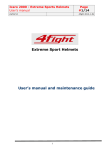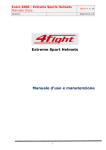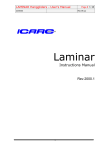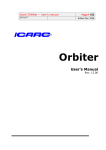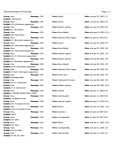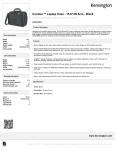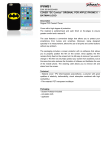Download User's manual and maintenance guide
Transcript
Icaro 2000 Extreme Sports Helmets - User’s manual 28/09/09 Page # 1 / 10 Update September 2009 Extreme Sport Helmets User’s manual and maintenance guide 1 Icaro 2000 Extreme Sports Helmets - User’s manual 28/09/09 Page # 2 / 10 Update September 2009 Icaro 2000 congratulates you on your purchase of this new extreme sports helmet. The principal purpose of our helmets, safety, has been achieved without sacrificing comfort or aerodynamic performance, by virtue of the innovative technology that we have applied. All Icaro 2000’s new helmets are tested at CSI (an organization authorized by the Ministry of Transport, with certification from Germany’s TUV), and they have attained certification as helmets for airborne sports, for hang gliding and paragliding, in accordance with the European standard EN 966. The “Fly” has also obtained certification in accordance with European standard EN 1077. Icaro 2000 recommends the use of certified helmets only Our network of distributors world-wide ensures the availability of parts and service wherever you go to practice your sport. Enjoy yourself!… For further information or service, please consult your nearest Icaro 2000 retailer, or contact the company direct at: Icaro 2000 srl Via Verdi, 19 21038-Sangiano, VA ITALY Phone: +39-0332-648-335 Fax: +39-0332-648-079 e-mail: [email protected] website: http://www.icaro2000.com 2 Icaro 2000 Extreme Sports Helmets - User’s manual Pagina #3/10 28/09/09 Update September 2009 INDEX GENERAL INFORMATION CHOOSING AND PURCHASING A HELMET THE STRUCTURE OF A HELMET USING THE HELMET 4 THINGS THAT YOU SHOULD NEVER FORGET IN CASE OF ACCIDENT HELMET MAINTENANCE 4 4 4 4 5 5 5 REMOVING AND FITTING THE INNER COMFORT LINING: 6 VISOR REMOVAL AND ASSEMBLY 6 SKYRUNNER FLY TZ, SKYRIDER E SCARAB 6 7 7 7 EAR PROTECTORS FLY AND SKYRUNNER DEMI JET 8 8 INTERPHONE 8 CLEANING VISOR AND EXTERNAL SHELL INTERNAL PARTS 9 9 9 ACCESSORIES 9 IMPORTANT INFORMATION 10 3 Icaro 2000 Extreme Sports Helmets - User’s manual Pagina #4/10 28/09/09 Update September 2009 General information Choosing and purchasing a helmet When you purchase a helmet, the most important moment is choosing the right size. If you have never purchased a helmet, you probably don’t know your own size. Take your time when choosing a helmet. Try several, and follow these criteria: Put the helmet on and fasten the strap: The helmet should not be so loose that it moves around, but neither so tight that you can feel a continuous pressure on your head A helmet that is too large may slide down and obstruct your eyes Try to pull it off, moving it back and forth: if it tends to slip off or move around, it is too large Lean your head forwards, grip the helmet’s rear edge, and try to pull the helmet off. If the helmet slides off, it is not suitable for the shape of your head. When compared with the jet, or open-face, helmet, the full-face helmet also guarantees protection for the chin area. Consider this carefully when you are choosing your helmet. If, while trying on the helmet, it does not perform satisfactorily for just one of these criteria, you should try another size or another model. Never purchase a second-hand helmet, even it the price is good. There is no way of discerning its real conditions (whether it has been involved in an accident, etc.). The structure of a helmet Outer shell: o thermoplastic or composite fibre material. These materials give the external shell high perforation resistance, strength, elasticity, and lightness. Crushable foam inner shell: o expanded polystyrene. It is damaged even by a minimal blow, and in this case the helmet should be replaced. Comfort lining: o expanded polyurethane and transpirant, non-allergenic textile. Its purpose is to adapt the helmet to different sizes, while also guaranteeing comfort and hygiene. It may be removable and washable. Vents: o provide internal ventilation and air circulation. Chin strap. o This usually has a rapid fastening system. Visor: Anti-abrasion thermoplastic material; it may also be anti-fogging. It should be replaced when vision is impeded by small scratches on the surface. The visor also not only increases the helmet's passive safety characteristics, but also its active safety, by increasing the width of the field of vision when compared to the use of any type of sunglasses. Using the helmet Once you have chosen the most suitable helmet, make sure that you wear it correctly. For safety, it should always fit snugly, and the strap should be tightly fastened. A helmet will never be able to guarantee total protection for the head when subject to the forces produced by 4 Icaro 2000 Extreme Sports Helmets - User’s manual Pagina #5/10 28/09/09 Update September 2009 whatever type of impact. However this is no excuse to forego wearing a helmet. You should always wear your helmet, in order to exploit the protection that it provides, whatever impact may occur. 4 things that you should never forget 1. Before using the helmet, read all the instructions, and follow the suggestions carefully to ensure a correct fit. 2. Do not use the helmet without fastening the strap. An unfastened helmet will fall off during the first impact, leaving the head defenceless for successive impacts. There is also the risk of it falling off during flight. 3. Do not fasten the helmet using just the velcro. The velcro that may be present on the strap serves purely to stop it flapping in the wind. 4. To ensure maximum performance, never modify your helmet, whatever the circumstances. In case of accident If the accident happens to you: o The inner shell will be deformed – though the deformation may not be visible to the naked eye – because it has absorbed the impact. o After an accident, even if the impact was minor, the helmet should be replaced, regardless of whether there is visible damage or not. If you witness an accident: o Keep calm. o Report the accident immediately, if possible by phoning for an ambulance (dial 118 in Italy). Only medically-qualified personnel know exactly how to deal with injuries. o Never move an injured person, unless this is absolutely essential because of a situation of greater danger. If the spinal column is damaged, moving the injured person could damage the spinal cord, causing permanent paralysis. o If the victim is wearing a helmet, do not remove it, but open the visor to facilitate respiration. o Keep the victim calm, and, if possible, cover him. Shock provokes shivering and a sensation of cold. o Do not give the victim alcoholic drinks. o Stem the flow of blood from wounds, protecting your hands with gloves or similar, throwing them away later if they have been dirtied with blood. Do not apply tourniquets: if you place a tourniquet in the wrong position, you could worsen the situation. o Never put the victim into a private car. Wait for the ambulance. If the victim is conscious, talk to him or her and try to calm him or her down. Helmet maintenance The helmet protects your head, and so it should be treated with care. The visor should be changed when it has scratches preventing satisfactory vision. The helmet can be seriously damaged by: Paints and varnish Petrol All types of chemical solvent Excessive heat (do not leave your helmet exposed to the sun) Inappropriate modifications Scrupulously follow the instructions provided by the manufacturer. 5 Icaro 2000 Extreme Sports Helmets - User’s manual Pagina #6/10 28/09/09 Update September 2009 Never modify your helmet in any way. If you think that the helmet that you have chosen is not right for the shape of your head, replace it… and this time choose more carefully! A helmet does not have a fixed lifespan. However, it is a good rule to replace it after five years of correct use. Removing and fitting the inner comfort lining: Important: do not use sharp or pointed tools such as screwdrivers etc., unless specifically requested in the instructions, in order not to scratch the helmet or damage its structure. For some models, as previously mentioned, the inner comfort lining can be removed in order to wash or replace it. In this case, the padding, which consists of a single piece or several components, is fastened to the inner polystyrene shell by means of a series of Velcro fasteners, and it is fixed at front and back by tabs that slot between the outer shell and the internal polystyrene shell. Before removing the padding, it is a good idea to make a note of the position of the various padding components and of the ear protectors, if present, and likewise their position with respect to straps and other parts. Disassembly is easy to perform. You just have to be careful when unfastening the Velcro, gripping the Velcro tape itself and not pulling on the padding. The same technique should be used for the tabs: pull the tabs themselves, while gently and slightly separating the external shell and the internal polystyrene shell. To reassemble the lining, just reverse the removal sequence, ensuring that all parts of the comfort lining are repositioned centrally and symmetrically, and checking the correct position of all the parts. When you are sure that all parts of the lining have been reassembled correctly inside the helmet, press firmly over the Velcro fastening strips in order to fasten the lining. Visor removal and assembly The visor can be removed in order to clean it thoroughly or replace it. If you decide to fly without the visor, remove all the components that are not part of the helmet shell itself, and cover the holes with the adhesive pads supplied. After a period of time, it may be necessary to replace the visor friction components. Place the helmet onto a table, ensuring that it is entirely stable, and lower the visor into its position of normal use. Important: be careful not to scratch the helmet shell or the visor with a screwdriver or other potentially abrasive or damaging tools during assembly and/or removal. Do not touch a mirror-finish visor with your hands (the acid content of sweat may cause it to become opaque). Assembly On each side of the outer shell, there is a single hole with a threaded bush. Attach the adhesive rubber washer to the outer shell of the helmet, ensuring that the hole of the washer corresponds to the threaded hole in the helmet shell. 6 Icaro 2000 Extreme Sports Helmets - User’s manual Pagina #7/10 28/09/09 Update September 2009 Position the aluminium and rubber washer and the fixing screw into one of the lateral holes of the visor. Keeping the washer and screw in contact with the visor, screw in the screw until you feel a light locking force. Repeat on the other side. The friction resistance of the visor is determined by the tightness of the screws. Removal Unscrew the two lateral fixing screws. SkyRunner Assembly On each side of the outer shell, there are three holes in alignment: the central hole is threaded, and the other two have no thread. Two serrated plastic washers and two small screws are supplied with the visor. The washers have two small projections on the inside surface. Take one of the washers and push it into the hole on the visor. Ensure that it is positioned so that the stop lug in the hole on the visor is below the rear projection on the washer. Holding the washer firmly pressed against the visor, insert the projections on the washer into the two non-threaded holes on the side of the helmet shell. Then introduce one of the screws into the threaded hole, and, using a screwdriver, screw down until a light locking force can be felt. Repeat the procedure on the other side of the helmet. The friction resistance of the visor is determined by the tightness of the screws. Removal Unscrew the two lateral fixing screws. Remove the washers from their locating holes. Fly Assembly On each side of the outer shell, there is a single hole with a threaded bush. Position the threaded part of the large aluminium screw into the centre of the plastic fastening component. The lug on the plastic part must be towards the front. Insert the screw and the plastic part into the lateral hole of the visor. Introduce the screw into the hole on the side of the helmet, and screw it in until you feel a light locking force. Repeat the procedure on the other side of the helmet. The friction resistance of the visor is determined by the tightness of the screws. Removal Unscrew the two lateral fixing screws. TZ, SkyRider e Scarab Assembly On each side of the helmet there are two holes with threaded bushes. Place the plastic screw with chamfered washer into the front aperture on the visor. On the inner face of the visor, place the flat washer onto the screw (this washer is not present in the Scarab). 7 Icaro 2000 Extreme Sports Helmets - User’s manual Pagina #8/10 28/09/09 Update September 2009 Fasten the screw partially onto the helmet shell, using the front threaded hole. Repeat the operation on the other side. Then place the aluminium washer with rubber section and the principal fixing screw into the rear aperture of the visor Keeping the washer and screw in close contact with the visor, screw until you feel a light locking torque. Repeat the operation on the other side Finalize assembly by screwing down the plastic screws completely. Removal The visor can be rapidly removed simply by reversing the assembly procedure. Unscrew the two screws that guide and damp the visor’s movement, from the two front threaded holes. Unscrew the screws in the rear holes, holding the visor to the helmet. Ear protectors FLY and SkyRunner Demi jet Removal The Fly helmet is sold with ear protectors. These can be removed by simply unfastening the two snap buttons on the side straps. The ear protectors are removed by pulling them out from their location. Assembly As there is limited space between the outer shell and the inner polystyrene shell, the ear protectors should be inserted with great care. Insert the upper tab on the ear protector into the space between the outer shell and the inner polystyrene shell, holding the outer edge of the ear protector. Once the two ear protectors have been correctly and symmetrically positioned, the two snap buttons simply have to be fastened to complete assembly. Interphone Fitting the interphone onto the shell Fastening the interphone onto the helmet shell makes it possible to position the earphones at a small distance from the ears rather than in direct contact. This improves comfort on long flights. To fix the interphone, the only tool needed is a small screwdriver. On each side of the helmet, there are two pairs of holes. The front pair of holes has threaded bushes, and this pair should be used to fit the visor. So we will be working with the other pair of holes, with no thread. Remove the two screws, which are temporarily held in position by adhesive tape, from the earphone supports. Inside the helmet, lift the edge of the padding along the inner side of the lining, exposing the hole into which the screw removed from the earphone support should be positioned. The earphone support has a small plastic lug, which will be positioned in the hole in front of that used for the screw. Place the screw into position, pushing it from the inside right through the outer shell. Screw it to the earphone support, ensuring that the lug on the earphone support is correctly inserted into its respective hole. This completes assembly for the first earphone. Repeat the procedure on the other side. Insert the electrical cable between the two earphones into the space between the polystyrene shell and the outer shell, without applying excessive force. 8 Icaro 2000 Extreme Sports Helmets - User’s manual Pagina #9/10 28/09/09 Update September 2009 Assembly of the interphone in headset format This system makes it possible to use the interphone system without wearing the helmet. Of course, in this case the arch linking the earphones is very narrow, and in fact it can be placed directly on the head like a normal headset, under the helmet. Removing the interphone from the shell Just follow the assembly instructions in reverse order: Remove the electric cable linking the two earphones and running between the polystyrene and the outer shell. Inside the helmet, lift the edge of the padding along the inner side of the lining, exposing the screw that holds the earphone support to the helmet shell. Unscrew the screw, and remove it from the hole. Repeat the operation for the other earphone Cleaning Visor and external shell Use only water and neutral liquid soap and a soft cloth for drying the visor. Do not rub the visor too hard. Internal Parts Interior polystyrene Use only a damp cloth. Leave to dry at room temperature, protected from direct sunlight. Comfort lining Hand-wash carefully, using just water at maximum 30° C and neutral soap. Rinse in cold water. Leave to dry at room temperature, protected from direct sunlight. Accessories Visors are available in different colours. They are easy to replace, enabling you to give the helmet optimum performance in differing light conditions. In addition, the internal structure of the helmets enables the application of a range of accessories. For further information, see our website: www.icaro2000.com 9 Icaro 2000 Extreme Sports Helmets - User’s manual 28/09/09 Pagina #10/10 Update September 2009 Important information Pilots who are used to flying with just sunglasses or even with no eye protection at all may take a few flights to get accustomed to the visor. If you don’t feel comfortable with the visor to start with, just lower and raise the visor during your first flights with the helmet until you get used to it. In conditions of high humidity and/or large temperature excursions, the visor may fog. On such occasions you will immediately appreciate the difference between flying with sunglasses and with a visor: in the latter case, you just have to open the visor slightly to obtain the complete clearance of any fogging. A helmet with a visor produces a different air sound, and it makes it easier to hear your flight instrument. If you rotate your head into a lateral position, the detachment of the airflow from the visor could give rise to anomalous sounds (the jet effect), which disappear immediately after the normal flight position has been resumed. As described above, the helmet is not a rigid structure. It was designed so that its deformability enables it to absorb impact. For this reason, it is important to store the helmet so that while it is not being used, it is not exposed to anomalous stress that could damage its structure. For example, if you – as many people do – place the helmet in the harness backpack, make sure that no-one sits on it. Warning! Failure to follow these instructions could reduce the protection offered by your helmet. Icaro 2000 wishes you happy and safe flying. Icaro 2000 reserves the right to modify the characteristics of its products in any way, without any prior notice. 10










